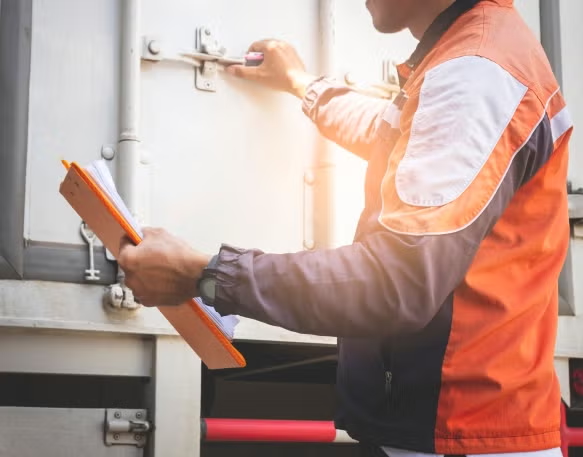
What is drayage? Understanding the basics, benefits, and best practices
Drayage plays a vital role in logistics and transportation. It facilitates the short-distance movement of goods between ports, rail terminals, and nearby warehouses. In this guide, we’ll define drayage and explore its various services. This guide will explore the definition of drayage, the different types of services available, and the key steps involved in the drayage process. Plus, we’ll highlight future trends in drayage logistics and share actionable insights and best practices to help businesses streamline their operations.
Understanding drayage: Essential information and best practices
Drayage is the short-distance transport of goods, often moving cargo from ports or rail yards to nearby distribution centers, warehouses, or transportation hubs. While it might not always get the spotlight, drayage is a vital part of the logistics and transportation industry, connecting long-haul intermodal rail transport with first and final delivery. These services are crucial for managing the flow of goods in intermodal transportation, making sure cargo moves smoothly between trucks, trains, and ships to keep supply chains on track.
As global trade and e-commerce continue to expand, the demand for efficient drayage logistics has become even more crucial. Drayage ensures timely, cost-effective delivery, reduces bottlenecks, and minimizes delays in freight movement. By understanding the basics of drayage, its benefits, and the best practices for optimizing these services, businesses can boost their supply chain efficiency and lower operational costs.
In this article, we’ll dive into the world of drayage, highlight its key benefits, and share best practices to help you make the most of it in your logistics operations.
Definition of drayage
Drayage is the short-distance transportation of goods, often between a port, rail yard, or warehouse and another location within the same general region. Its primary function is to move freight over short distances as part of the larger supply chain, typically serving as a key link between long-haul transport methods like ships, trains, and trucks. Drayage is essential in intermodal transportation, where goods transition between different modes of transport, ensuring the seamless movement of cargo from one stage to the next.
The term “drayage” originates from the word “dray,” which referred to carts pulled by horses in the early 19th century. These carts were used to transport goods over short distances within a city or town. With the advent of motorized vehicles, drayage evolved into its modern form, now relying on trucks and other vehicles to move freight quickly and efficiently.
Today, drayage plays a critical role in global logistics, especially in managing port congestion and streamlining supply chains as the volume of goods in trade continues to rise. As the logistics industry has evolved, so too has the complexity and importance of drayage, which now involves sophisticated coordination and technology to ensure that goods move smoothly between transportation modes.
Types of drayage services
Drayage services come in various forms, each tailored to specific transportation needs within the supply chain. These services are crucial for efficiently managing the movement of goods, especially in complex logistics networks. Below are the primary types of drayage services:
Intermodal drayage
Intermodal drayage involves moving containers between different modes of transport, such as transferring goods from a ship to a flatcar, or from a train to a truck. This type of drayage is essential in facilitating seamless transitions between transport modes, ensuring that cargo moves efficiently through the supply chain. Intermodal drayage plays a significant role in long-distance transportation, where multiple modes are required to reach a final destination.
Intra-carrier drayage
Intra-carrier drayage refers to the movement of goods within the same carrier’s network, such as transferring freight between two locations operated by the same carrier. This type of service helps streamline logistics operations by keeping goods under a single carrier’s control while managing short-distance movements between facilities or terminals.
Pier drayage
Pier drayage involves moving cargo from a port to a nearby warehouse, distribution center, or rail terminal. This is a common type of drayage service in port logistics, as it facilitates the quick transfer of goods from ships to inland transportation routes, minimizing port congestion and speeding up the delivery process.
Shuttle drayage
Shuttle drayage refers to short-distance movements of freight, often within the same terminal, port complex, or nearby storage facility. This service is typically used when containers need to be repositioned or temporarily stored until they can be transported to their final destination. Shuttle drayage helps optimize space and resources within busy port areas for efficient cargo management.
The drayage process
The drayage process typically involves several key steps, from picking up cargo at a port or rail terminal to delivering it to its next destination, such as a warehouse, distribution center, or another transport mode. Here is an outline of the typical drayage process:
- Cargo pickup: The drayage process begins when a drayage carrier receives an order to pick up a container or shipment from a port, rail terminal, or storage yard. The carrier dispatches a driver to retrieve the cargo, typically using a specialized truck or chassis for transporting shipping containers.
- Documentation and compliance: The driver must ensure all paperwork, including customs forms, freight invoices, and other regulatory documents, is in order before picking up the cargo. In international shipments, compliance with customs and port authority regulations is crucial to avoid delays. Failure to provide the correct documentation can result in penalties, fines, or extended wait times at the port.
- Cargo handling: Once the cargo is picked up, it is securely loaded onto the drayage truck or chassis. Depending on the size and type of shipment, specialized equipment may be used to handle the cargo safely. For example, containers are often loaded and unloaded using cranes or gantry systems at the port or rail terminal. Ensuring the proper handling of the cargo is critical to preventing damage.
- Transportation and coordination: After the cargo is loaded, the drayage truck transports it to its next destination, which could be a nearby warehouse, distribution center, rail terminal, or another transport mode (such as a long-haul trucking service). This phase requires careful coordination with other logistics providers, especially if the cargo is part of a larger intermodal shipment. The drayage carrier must ensure the timing aligns with scheduled transfers to avoid bottlenecks and keep the supply chain moving.
- Delivery and unloading: Upon reaching the destination, the cargo is unloaded and handed off to the next point in the logistics chain. This could involve delivering the shipment to a warehouse for storage, a distribution center for further processing, or directly transferring it to another transport mode for long-haul delivery. At this stage, the carrier provides final documentation and updates to confirm the successful delivery.
Benefits of drayage services
Drayage services come with plenty of perks for businesses eager to enhance their supply chain and simplify transportation. Let’s dive into some of the key benefits of using drayage services:
Efficient cargo movement
Drayage services ensure quick and easy transfers of goods between different transport modes, like moving cargo from ships to trucks or from rail to warehouses. By keeping things moving swiftly, businesses can cut down on delays and avoid bottlenecks in their logistics. This efficiency is especially important in time-sensitive industries, where even a short delay can affect delivery schedules and customer satisfaction.
Cost savings
Drayage services can help businesses reduce overall shipping costs through optimized logistics. By leveraging the expertise of drayage carriers, companies can benefit from efficient route planning, reduced idle times at ports, and quicker turnarounds, all of which contribute to cost savings. Additionally, drayage can minimize the need for long-term storage at expensive port facilities by moving cargo quickly to its next destination.
Flexibility
The flexibility of drayage makes it easy to handle all kinds of cargo, from standard shipping containers to specialized goods. Whether businesses are working with oversized freight, temperature-sensitive products, or high-value items, drayage providers can adapt to meet the unique needs of each shipment. Plus, they’re ready to adjust operations as logistics change, whether that means adapting to new transportation schedules or last-minute delivery shifts.
Regulatory compliance
Navigating customs and regulatory requirements can be complex, especially for international shipments. Drayage providers bring expertise in handling documentation and ensuring compliance with port, customs, and transportation regulations. Additionally, drayage drivers require a Transportation Worker Identification Credential (TWIC) card to access secure marine terminals and port facilities. By using drayage services, businesses can avoid costly fines, delays, and legal issues that could arise from non-compliance.
Challenges in drayage logistics
While drayage logistics plays a crucial role in the transportation industry, it also faces several common challenges that can disrupt the smooth movement of cargo. Recognizing these issues and using strategies to tackle them can help businesses keep their supply chains running efficiently.
Port congestion
Delays caused by congestion can result in missed delivery schedules, additional storage costs, and longer turnaround times for drayage trucks. To help overcome port congestion, businesses can employ real-time tracking and analytics to monitor port conditions and schedule pickups during off-peak hours. Working closely with drayage providers to ensure flexibility in scheduling can also help minimize delays. Additionally, using nearby off-dock facilities for temporary storage can alleviate the pressure at the main port terminals.
Equipment availability
Having the right equipment—like trucks, chassis, and containers—is key to keeping drayage services running smoothly. Unfortunately, shortages or delays in returning equipment can cause bottlenecks and drive up transportation costs. To tackle this, businesses can team up with multiple drayage carriers to tap into a larger pool of equipment. Plus, using technology to track equipment usage can help manage assets more efficiently. Some companies even look into dedicated chassis programs, where drayage providers reserve specific equipment for regular customers to ensure it’s always available.
Regulatory compliance
Navigating customs regulations, environmental standards, and transportation laws can be complex, especially when dealing with international shipments. Non-compliance with these regulations can result in fines, delays, and legal issues. For instance, ports may impose specific emissions standards or enforce weight limits that drayage trucks must adhere to. Staying informed about local, national, and international regulatory changes is key to ensuring compliance. Businesses can work with drayage providers experienced in handling regulatory requirements, and invest in compliance management tools to track documentation, licenses, and legal standards.
Best practices for effective drayage management
To keep drayage operations running smoothly and efficiently, businesses can follow these best practices:
- Partnering with reliable drayage providers: Selecting experienced and reputable drayage providers is crucial for minimizing delays, ensuring timely deliveries, and maintaining compliance with regulatory requirements. Reliable providers have established networks, industry expertise, and the necessary resources to handle complex drayage needs efficiently.
- Technology integration: Using modern software solutions for tracking shipments, managing routes, and optimizing schedules can significantly improve drayage operations. Technology platforms provide real-time visibility into cargo movements, reduce manual errors, and help coordinate with other logistics partners to ensure smooth transitions between transport modes.
- Coordination and communication: Clear communication between all parties involved—such as drayage providers, carriers, ports, and warehouses—is essential to avoiding delays, errors, and mismanagement. Establishing a communication framework ensures that everyone is aligned, and any issues that arise are promptly addressed.
- Strategic planning: Effective route planning and scheduling can help minimize delays, especially when dealing with port congestion or equipment shortages. By analyzing traffic patterns, peak times at ports, and coordinating closely with logistics providers, businesses can ensure more efficient cargo movement and reduce turnaround times.
Future trends in drayage
As the logistics and transportation world keeps changing, drayage logistics is seeing some exciting innovations. New trends and advancements are making drayage more efficient, sustainable, and adaptable.
- Automation: Automated systems for handling containers, real-time tracking, and digital documentation are speeding up drayage services and improving accuracy. Plus, the development of autonomous trucks could help lower labor costs and boost efficiency in short-haul freight transport.
- Electric drayage trucks: With sustainability becoming a top priority, electric drayage trucks are stepping up as a cleaner alternative to traditional diesel trucks. These vehicles produce zero emissions, which helps reduce the environmental impact of drayage, especially in busy urban areas and ports with strict pollution regulations. Companies are already testing electric trucks in several regions, and we can expect broader adoption as technology advances and costs go down.
- Sustainability Initiatives: Beyond electric vehicles, other sustainability initiatives are gaining traction in drayage logistics. Many companies are implementing strategies to reduce carbon footprints, such as optimizing routes to reduce fuel consumption and investing in eco-friendly equipment. Additionally, ports and logistics hubs are adopting green technologies, including solar-powered infrastructure and emissions-reducing technologies, to make drayage operations more environmentally responsible.
Elevate your drayage operations with DAT
Effective drayage management is essential for shippers and carriers to keep supply chains running smoothly. By understanding the basics, addressing challenges like port congestion, and leveraging innovative solutions, businesses can reduce costs and improve delivery timelines. Staying informed on trends like automation and sustainability ensures you remain competitive in a changing logistics landscape. Whether you’re coordinating drayage as a shipper or optimizing it as a carrier, adopting best practices will drive efficiency and keep operations on track.
Share
Related Articles
FAQs
A few things you might be asking yourself
Drayage in shipping refers to the short-distance transportation of cargo, typically between ports, rail terminals, or warehouses and another nearby location. It plays a key role in the logistics process, especially in intermodal transportation, by moving goods between different modes of transport, such as from a ship to a truck or rail. Drayage is crucial for connecting long-haul transport with local distribution and ensuring efficient supply chain operations. It also involves handling regulatory requirements and documentation to ensure the smooth movement of goods between transportation hubs.
An example of drayage is the movement of a shipping container from a seaport to a nearby warehouse. After a cargo ship docks at the port, a drayage truck picks up the container and transports it to a distribution center within the same city or region. This short-distance transport is a key link in the supply chain, allowing goods to transition from maritime transport to local delivery or further transit by rail or truck.
The key difference between freight and drayage lies in the distance and scope of transportation. Freight refers to the long-distance movement of goods, typically over hundreds or thousands of miles, using various modes of transportation like trucks, trains, ships, or airplanes. It encompasses the entire journey of goods from origin to destination. Drayage, on the other hand, is a specific type of freight service that involves short-distance transport, usually within a single metropolitan area, such as moving cargo between a port and a nearby warehouse or rail terminal.
Drayage can be expensive due to several factors. Port congestion often leads to delays, increasing wait times and costs. Equipment shortages, such as limited availability of chassis or trucks, also drive up prices. Labor costs are another factor, as drayage drivers and port workers are in high demand, resulting in higher wages and service fees. Fuel price fluctuations impact transportation costs, particularly for short hauls, while regulatory compliance with environmental and safety standards adds to operational expenses.
To connect with shippers who need drayage services, focus on building relationships with key players in the logistics industry. Start by networking with local logistics companies, freight forwarders, and port authorities, as they often work directly with businesses requiring drayage support. Partnering with freight brokers can also help you identify opportunities, as they coordinate shipments and may need reliable drayage providers. Additionally, attending logistics and transportation trade shows is an effective way to meet shippers face-to-face, establish trust, and grow your client base.
Streamline your operations with DAT
Are you ready to optimize your drayage operations and enhance your overall logistics strategy? By partnering with experienced drayage providers and using powerful tools like DAT load board, you can streamline cargo movement, minimize delays, and reduce shipping costs. Efficient drayage management is key to staying competitive in today’s fast-paced market, ensuring timely deliveries and better coordination across your supply chain. Whether you’re purchasing transportation or a transportation provider like a broker or carrier, DAT has solutions for you.




